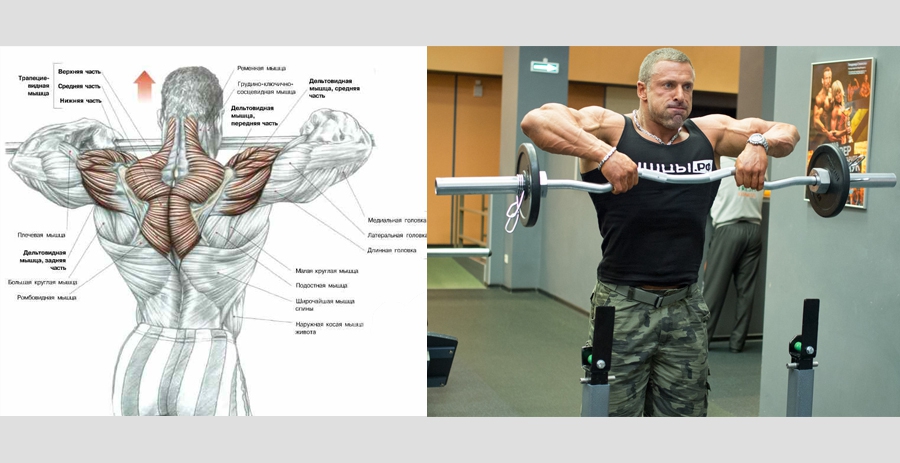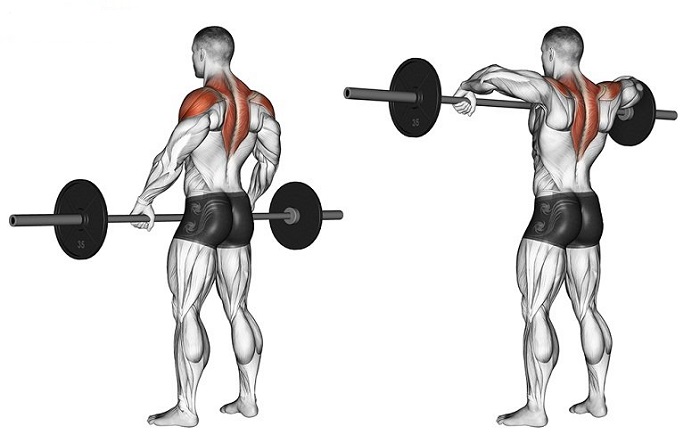Barbell pull to chin is a basic exercise for developing the deltoid muscles (mainly the middle head), also involving the trapezius muscles.
Content
Benefits and Applications
The pull of the bar to the chin is an excellent exercise that specifically loads the middle beams of the deltas. After performing several sets, the middle bundles of deltas burn with tension. All you need is a barbell and a relatively moderate working weight.
The exercise is used in bodybuilding, powerlifting and other strength training.
The main version of the exercise is pulling the barbell to the chin with a wide grip.
Technique for pulling the barbell to the chin
- Take the barbell with an overhand grip (the grip is slightly narrower than shoulder width) and stand straight, your back is slightly arched at the waist, your chest is “wheeled”, your shoulders are straightened, your arms are straightened at the elbows, the barbell lies on your hips.
- Inhale and, holding your breath, tighten the trapezium and deltas. Spreading your elbows, pull them vertically up.
It is the elbows that “lead” the movement, not the shoulders or forearms. - When you pull your elbows up, the bar of the bar should slide in a vertical plane along the body from the hips to the chin. Do not hang over the bar by arching your back.
- Keep your torso and neck straight and your chin horizontal.
- At the top point, the elbows are raised as high as possible (definitely above the shoulders), and the upper part of the arms is 30 ° above the horizontal.
- Having reached the top point, exhale, pause and tighten the trapeze and deltas even more.
- Slowly lower the bar to the starting position and thus complete the required number of repetitions
.
Recommendations and common mistakes
- The pace of the exercise is slow and highly technical. The movement is quite traumatic, so watch the technique.
- Elbows should be spread apart and rise vertically, strictly in the plane of the body. If, while raising your elbows, you direct them forward, beyond the line of the body, then the load will shift from the middle deltas to the front ones.
- An overly narrow grip will force you to push your elbows forward and limit your range of motion.
- Weight should be optimal, no cheating and not full amplitude.
- Do not slouch during the exercise.
Barbell to Chin Options
There is another option: pulling the bar to the chin with a narrow grip, but it redirects the load more to the front beams and trapezium, while less load is placed on the elbows than with a wide grip. Another advantage of this option is a wider range of thrust. For a narrow grip, it is better to use the EZ neck, it is most convenient for the hands.
Alternatively, alternate the execution options, for one week we do a wide grip barbell row to the chin, then in the second week we change the option to a barbell row to the chin with a narrow grip and in the third week we switch to a wide grip again. After several such cycles, you yourself will understand which option is more effective for you.
You can also do deadlifts on the Smith machine. And here it is possible to perform the movement even with one hand.
This variation has many advantages. There is no locking of hands with a neck in a rigid frame.
You grab the bar with one hand in a position that mimics a wide grip and miraculously does not feel any discomfort in the shoulder joint! What's more, the range of thrust magically lengthens!
The bar can, indeed, be pulled up to the chin, although before it barely reached your collarbones. And besides, mental concentration increases dramatically. You will clearly feel how your delta works!
It seemed that they would have to pay for the pluses by reducing the working weights. But no! It was you who had less weight before. Mainly because you spent part of your strength on maintaining balance.
Now you are relieved of the inconvenience, and your working weight per arm is guaranteed to grow by 10-15%! Therefore, with a high degree of probability, the return of the training will also increase!
However, when doing chin rows with one hand, it is not recommended to perform forced and negative repetitions while helping yourself with the other hand. This unnecessarily increases the risk of injury to the shoulder joints. It is also unacceptable to start the repetition with a jerk..
Conclusions
A good basic exercise that works deltas and partially trapezium.
It is optimal to set in the middle of the deltoids workout, for example, immediately after the bench press.
Useful links
https://www.youtube.com/watch?v=Fq67opsS_hc




